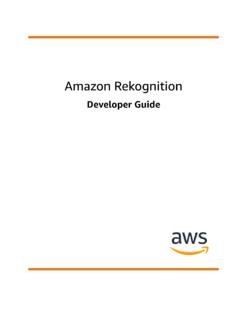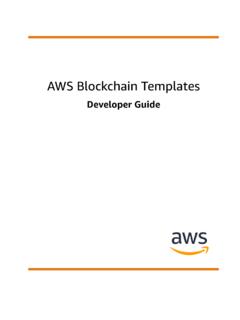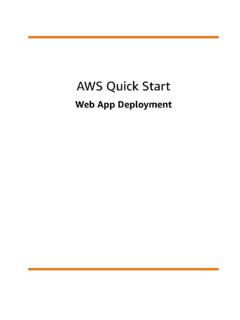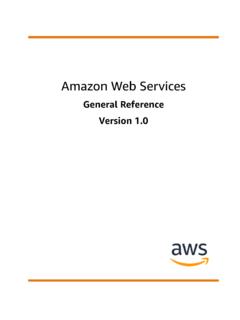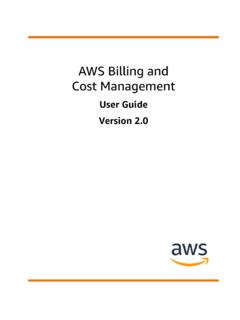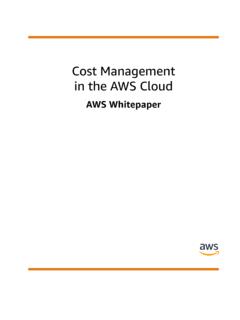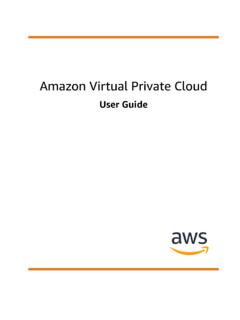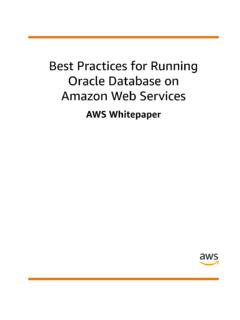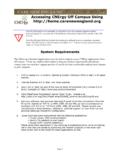Transcription of Getting Started with AWS
1 Getting Started with AWSD eploying a Web ApplicationGetting Started with AWS Deploying a Web ApplicationGetting Started with AWS: Deploying a Web ApplicationCopyright 2018 Amazon Web Services, Inc. and/or its affiliates. All rights 's trademarks and trade dress may not be used in connection with any product or service that is not Amazon's, in any mannerthat is likely to cause confusion among customers, or in any manner that disparages or discredits Amazon. All other trademarks notowned by Amazon are the property of their respective owners, who may or may not be affiliated with , connected to, or sponsored Started with AWS Deploying a Web ApplicationTable of ContentsDeploying a Web App.
2 1 AWS Elastic Beanstalk .. 1 The Signup 1 Amazon DynamoDB .. 2 Amazon Simple Notification Service .. 2 Prerequisites .. 3 Sign Up for AWS .. 3 Download the Code for the App .. 3 Create an IAM Policy and Role .. 3 Step 1: Create a DynamoDB Table .. 5 Step 2: Create an SNS Topic .. 6 Step 3: Deploy the App .. 7 Create an Elastic Beanstalk Environment .. 7 Create the Source Bundle .. 7 Deploy the Signup Application .. 8 Test the App .. 8 Troubleshoot Deployment Issues .. 9 Step 4: Change the App 11 Step 5: Clean 13 Delete AWS Elastic Beanstalk Resources .. 13 Delete the Amazon DynamoDB Table.
3 13 Delete the Amazon SNS Resources .. 13 More AWS Deployment Options .. 14iiiGetting Started with AWS Deploying a Web ApplicationAWS Elastic BeanstalkDeploying a Web App Using ElasticBeanstalkUsing AWS, you can develop web apps quickly and then deploy them to a cloud environment that scaleson demand. And with several AWS deployment services to choose from, you can create a deploymentsolution that gives you the right mix of automation and this tutorial, we'll assume that you're working on a new web app that isn't ready for production yet,but in the meantime you plan to deploy a small placeholder app that collects contact information fromsite visitors who sign up to hear more.
4 The signup app will help you reach potential customers peoplewho might become early adopters or take part in a private beta 's a quick introduction to AWS Elastic Beanstalk and the other technologies we'll be using. (To diveright into the hands-on part of the tutorial, skip ahead to the next section (p. 3).)AWS Elastic BeanstalkElastic Beanstalk is a high-level deployment tool that helps you get an app from your desktop to theweb in a matter of minutes. Elastic Beanstalk handles the details of your hosting environment capacityprovisioning, load balancing, scaling, and application health monitoring so you don't have Beanstalk supports apps developed in Java, Go, PHP.
5 NET, , Python, and Ruby, withmultiple configurations for each platform. A platform configuration defines the infrastructure andsoftware stack to be used for a given environment. When you deploy your app, Elastic Beanstalkprovisions a set of AWS resources that can include Amazon EC2 instances, alarms, a load balancer,security groups, and more. The software stack that runs your application depends on the platformconfiguration type. For example, Elastic Beanstalk supports 3 configurations for Python: Python ,Python , and Python can interact with Elastic Beanstalk by using the AWS Management Console, the AWS CommandLine Interface (AWS CLI), or the Elastic Beanstalk CLI, a high-level CLI designed specifically for ElasticBeanstalk.
6 For this tutorial, we'll use the AWS Management Signup AppIn this tutorial, we'll deploy an example app that lets customers submit contact information and expressinterest in a preview of a hypothetical web app that you're app is built on , a platform that uses server-side JavaScript to build network consists of a library and a runtime. The runtime is provided by the V8 JavaScript is designed around a non-blocking, event-driven I/O model, which makes it useful for creatinghighly scalable web servers. Our app employs two external Node modules: Express, a web applicationframework, and Jade, a template engine that can be used to create HTML provides a SDK, which helps take the complexity out of coding by providing JavaScriptobjects for AWS.
7 We've used the SDK to build our sample application. To learn more about SDK, see AWS SDK for JavaScript in Started with AWS Deploying a Web ApplicationAmazon DynamoDBTo make our app look good, we use Bootstrap, a mobile-first front-end framework that Started as aTwitter DynamoDBWe'll use Amazon DynamoDB, a NoSQL database service, to store the contact information that userssubmit. DynamoDB is a schema-less database, so you need to specify only a primary key attribute. We'lluse an email field as a key for our Simple Notification ServiceWe want to be notified when customers submit a form, so we'll use Amazon Simple Notification Service(Amazon SNS), a push messaging service that can deliver notifications over various protocols.
8 For ourapp, we'll push notifications to an email Started with AWS Deploying a Web ApplicationSign Up for AWSP rerequisitesBefore you start this tutorial, complete the following Sign Up for AWS (p. 3) Download the Code for the App (p. 3) Create an IAM Policy and Role (p. 3)Sign Up for AWSWhen you sign up for Amazon Web Services (AWS), your AWS account is automatically signed up for allservices in AWS and you can start using them immediately. You are charged only for the services that you created your AWS account less than 12 months ago, you can get Started with AWS for free. Formore information, see AWS Free you have an AWS account already, skip to the next step.
9 If you don't have an AWS account, use thefollowing procedure to create create an AWS , and then choose Create an AWS might be unavailable in your browser if you previously signed into the AWSM anagement Console. In that case, choose Sign in to a different account, and then chooseCreate a new AWS the online of the sign-up procedure involves receiving a phone call and entering a PIN using the the Code for the AppYou can download the code for the app from the AWS Labs GitHub repository. Open eb-node-express-signup repo and then choose Download 're going to make a few changes to the code as you complete the tutorial, so you need to unzip The code for the app is stored in the eb-node-express-signup-master an IAM Policy and RoleNext you need to create an IAM role that grants your app permission to publish Amazon SNSnotifications and put items into your DynamoDB table.
10 You will apply the role to the EC2 instances thatrun your application when you create an AWS Elastic Beanstalk Started with AWS Deploying a Web ApplicationCreate an IAM Policy and RoleTo create an IAM the AWS Identity and Access Management (IAM) console at the navigation pane, choose Create the file from the eb-node-express-signup-master directory andcopy its contents. Paste the contents into the policy document Review Name, enter Create an IAM role and attach the policy to create an IAM the navigation pane, choose Create Choose the service that will use this role, choose EC2 to allow EC2 instances to use the roleto call AWS services on your behalf.
